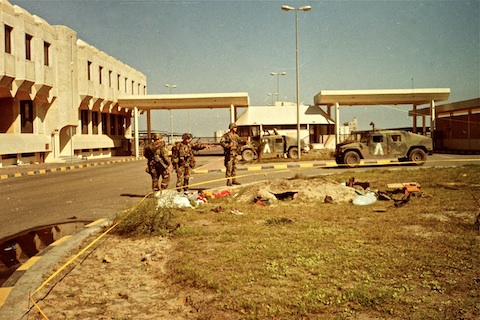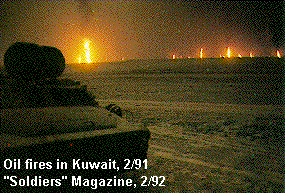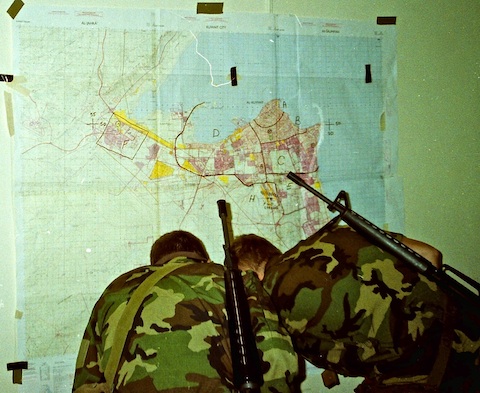North to Kuwait City
Kuwait City—The indoor City, sheltered by the huge warehouse and surrounded by a mile-long concrete protective wall, was a world apart from what unit members were to find outside, beyond the city’s wall. On Friday, March 1, a small group sallied forth to take on the unit’s first mission in Kuwait City. The group was to assess conditions at pre-selected points where relief material were to be distributed. What awaited the team members was totally unexpected.

The large number of Kuwaiti cars carrying flags and speeding along the freeways, still littered with war debris, provided the first surprise. Happy Kuwaiti drivers, with friends and families stuffed ito their cars, sped by honking, waving, and making “V” for victory gestures. Free gas for all the people paid off. The people could drive around jubilantly spreading the excitement of their newly acquired freedom. The American presence seemed to enhance the mood.
In the Bayan neighborhood, one team stopped to inspect a local store which had been picked as a future distribution point. Before any inspectig could be done however, a smalll crowd gathered and the team’s interpreter, SGT Hamad Al-Sabah, began speaking with the people. SGT Hamad was a memher of the royal family, but at this point the most important thing was the desire of the people to start describing their seven-months’ ordeal.

The conversation and the gesturing commenced, at rapid fire speed. Soon a lady appeared in the crowd with a tray bearing a tea dispenser and enough cups for the entire team. SGT Hamad relayed the story to the other team members of how that lady was the heroine of the neighborhood. She was the first to enter the nearby jail, freeing Kuwaiti prisoners after the Iraqis left, getting a bomb defused, and raising a Kuwaiti flag over the jail. She praised the Americans and offered to cook for them all.
Other people in the crowd had their own stories to tell: of friends being pulled out of bed by the Irais, taken into the street and shot; of a father who shot an Iraqi who killed his son; and of less painful things, merely inconveniences, like scarce water and no utilities. People in the crowd offered the team bottles of water, and refused to take them back when team members objected. How the lady had cooked tea remained an unanswered question. People, both team members and local residents, took pictures. Children were picked up; kisses were exchanged. Why does it take war to make people so happy? Another unanswered question.
Somehow, after a couple hours, the team left and returned to its base. The first day of work was done. One site was visited. How would the 432nd manage to visit hundreds more?

McMurry’s Notes
- The reception we got was truly fantastic, but the thing that surprised me most was the almost complete lack of destruction. The Iraqis had been carpet-bombed, but that was in the desert and the “Valley of Death” was northwest of Kuwait City. There were bullet holes in the streets, as if from strafing, the oil wells were on fire, and many of the shops had been looted (particularly car dealers, jewelry shops and electronics stores.) But Kuwait City was structurally intact. It definitely wasn’t the Stalingrad the media made it out to be. The people were another story. They suffered horribly from Iraqi atrocities.
- The typical Kuwaiti house did not look like much from the outside. But the elegance inside them was incredible. One house that I searched for UXO belonged to a police captain. It looked like something one would find in Hollywood: fountain in the courtyard, mirrored weight room, etc. Even in the poorer neighborhoods, the houses had obviously been very comfortable and well-appointed before the war.
- March 19 letter home
| Page 17 | Page 18 | Page 19 |
